Easter Break:
Visiting Berlin was pretty surreal for me, and the experience was much more enhanced with crap weather (except for our second day). When you learn about World War II in school you’re just reading it out of a textbook or learning it through your teacher’s perspective. But when you visit this city that was torn apart until 1989, all of those horror stories you read about in textbooks comes to life. I think the only way you can “see” Berlin is by going on a walking tour or two. If you don’t like walking tours because you’d rather do non-tourist things, that’s cool too. Now for those who plan on visiting Berlin in the near future, just be warned that you may be spoiled by this blog post. However, I won’t go into too much depth about the history aspect because I am assuming you all learned about World War II in primary and secondary school.
Four of us made the trip to Berlin via an overnight bus that took about 8 hours. I didn’t really sleep well on the bus as I had an aisle seat, and when we arrived it was raining (of course) and we got lost trying to find our hostel. There are so many different means of public transportation in Berlin: train, tram, bus, or taxi, and the routes seem awfully confusing.
Berlin has this rugged feel to it; it is more run down and there are a lot of homeless people near train stations–it sort of reminds me of Edmonton. I visited München (Munich) about 3 years ago and it was more posh than Berlin. However, I can understand why Berlin is a bit more dingy and I think it is because of the turmoil this city has been through in the 20th century. This city had to be rebuilt after World War II because 80% of it had been destroyed. So in retrospect, this city is quite “new” but nevertheless, the history still remains.
After leaving our bags in a locker at the hostel, we made our way to Pariser Platz where the famous Brandenburg Gate stands. From here we went on a “free” walking tour around the city.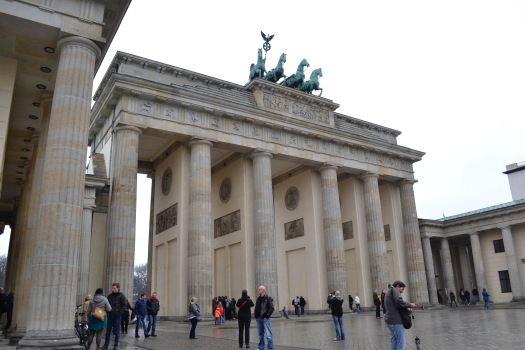

This is the same hotel Michael Jackson stayed at when he was caught dangling his child over the balcony. It is also one of the most expensive hotels in Berlin.
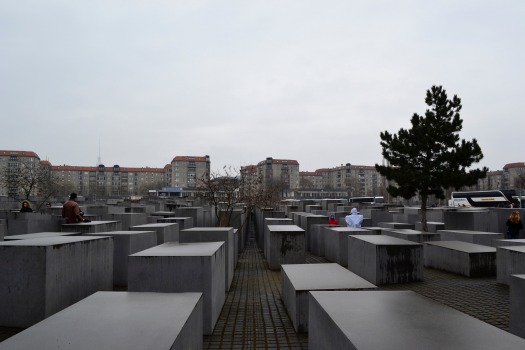
This is the Holocaust Memorial (or the Memorial to the Murdered Jews of Europe). It is located near the Brandenburg Gate and the Großer Tiergarten in Berlin. What’s interesting about this memorial is that the design is open for interpretation. The blocks are different lengths, widths, and heights, and as you move further inwards the ground goes deeper. I think that the various sized blocks’ represents the lives of different people who all had unique qualities and talents, but were viewed as the “same” under Hitler’s rule.

I didn’t really want to smile in this picture because I was inside a memorial…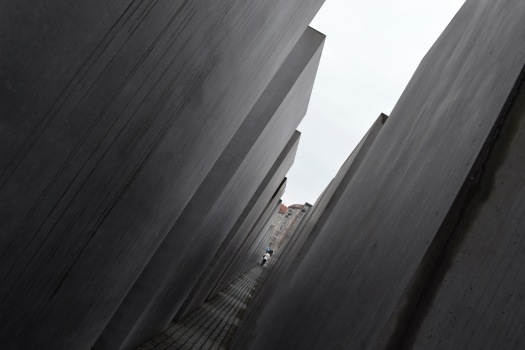
Next we viewed what came-to-be my favourite building in Berlin: the Reichsluftfahrtministerium (the Reich Air Ministry). It’s got this masculine feel to it, and honestly it looks kind of intimidating–that is why I like it. It was once home to the Reich Air Ministry where the development and production of aircraft for the Luftwaffe took place. I didn’t get a picture of it, but on the sides of the building you can see faint bullet holes. It was also one of the few buildings in Berlin that was not seriously damaged by allied bombings in 1944-45. Today it is now known as the Detlev-Rohwedder-Haus or the German Finance Ministry.

(http://www.xn--sehenswrdigkeitenberlin-ipc.net/reichstag/)
Of all the pictures I took in Berlin, I didn’t one get a shot of the Reichstag. This building was an important monument throughout Berlin’s history. This Italian High Renaissance style architecture took ten years to construct and was completed in December of 1894. According to our guide (and other resources) it was severely damaged in a fire in 1933. This was a pivotal point in history for the future of German politics and a devastating war that was to come. Apparently it was no accident. Hitler already did not have a majority of seats in the Reichstag and he was worried he would not receive enough support in the upcoming election. So in order to overthrow the Communist opposition he decided to set fire to the Reichstag. In this, he was able to scare the German people into thinking that the Communists were trying to take over so he could receive political support for his party, the Nazi’s. This and many other instances proved that Hitler was very manipulative, and his influence among the German people was heavily successful in the years to come.
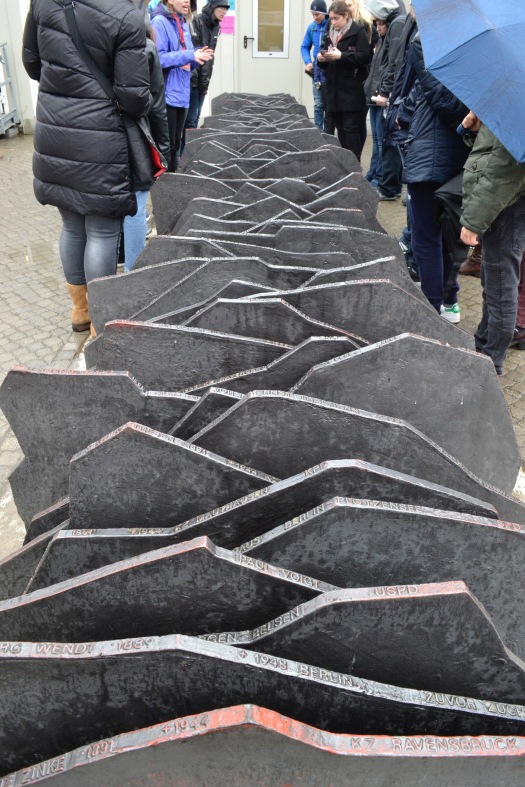
That brings me to my next picture, the Memorial to the Murdered Members of the Reichstag. These cast iron slabs commemorate 96-known members of the Reichstag parliament who were murdered or imprisoned by the Nazi party between 1933-1945 (and 1948). Most of these people represented opposing political parties such as the Communists, and the Social Democrats. May those innocent souls rest in peace.
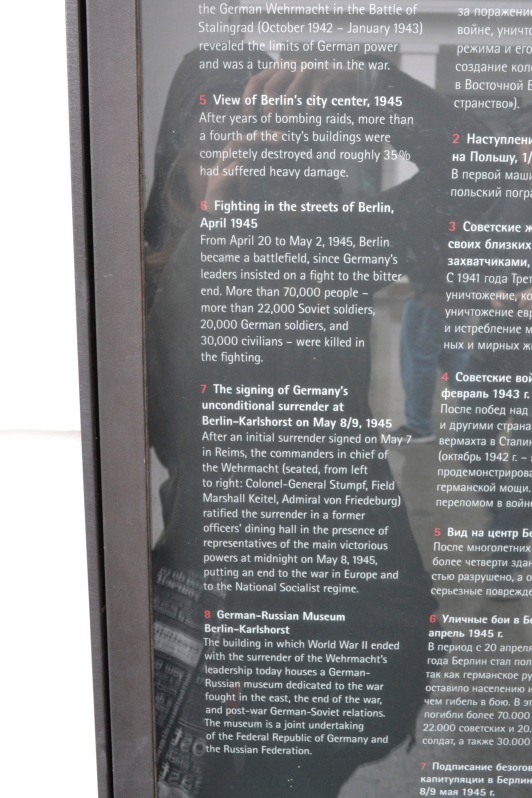
As you can probably guess by the inscription this is the Soviet War Memorial (Tiergarten). It was built by the Soviet’s themselves to remember the thousands of Soviet soldiers who lost their lives during the Battle of Berlin during April and May of 1945. There are more than 2,000 graves situated beneath the memorial. Also, the bronze statue of a Red Army soldier you see in the photo above has some significance. The position of his gun hanging from his right shoulder represents the end of war; and his outreached left hand shows you that his fallen comrades are buried below.
According to our guide this memorial was very (or still is) quite controversial in Berlin. When the Red Army made their way into Berlin countless women were raped by soldiers. Some people feel like this memorial (and the other Soviet memorial in Berlin) should not be here because these soldiers did terrible things to the women in Berlin, and therefore should not be remembered. It’s unclear how many victims there were, but I believe this did happen, among all the other gruesome things that happened during this war.

Checkpoint Charlie is a famous tourist attraction in Berlin. In fact this isn’t even the exact location of where the real Checkpoint Charlie was–including the little kiosk house you are unable to see in this picture due to a flock of tourists. Our tour guide mentioned it briefly, so I will as well. In case you don’t know what it’s about, it was a crossing point between East and West Berlin between 1961 and 1989, and it was managed by the U.S Army on the West side. It was erected by communist East Germany in order to prevent citizens from fleeing to the democratic West side. This was the only crossing point for tourists, diplomats, and military personnel from the Western forces during this period.

What remains of the Berlin Wall.
Those were my highlights of Berlin, but I encourage you to visit the city if the Second World War interests you. I will admit I was a complete tourist in Berlin and tried to soak up as much history as I possibly could. The day after we visited the Sachsenhausen Concentration Camp which is just outside of Berlin in Oranienburg. It was built in July of 1936.
I recommend visiting a concentration camp such as this one with a guide. We went on another walking tour and it lasted about 5 hours, but it was totally worth it! We learned a lot about life at a concentration camp. When our guide was explaining some of the horrific events that took place at this camp, my stomach would turn and I felt an incredible sense of sadness for the people who suffered here. It also reminds me that there are people in the world today that are also suffering either from starvation, and abuse, and I wish I could give them my freedom to live a prosperous life. I’ve also been interested in the North Korean regime lately, and I can hardly believe that people in these countries have no freedom yet and it’s already 2016.
If you stepped within the Neutral Zone you would be shot.

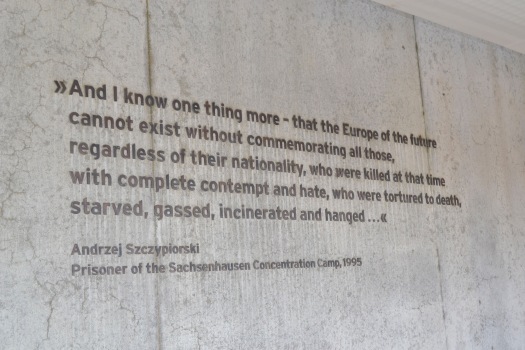
The exact number of people who died here is unknown. It is estimated that an upwards of 35,000 people died here from malnutrition, disease, pneumonia, mass killings, medical experiments, and the list goes on.

The camp was liberated on April 22, 1945 by a unit of the 47th Soviet Army. Despite being freed, some inmates died days after liberation because most of them were medically ill.
What remains of the gas chambers. Again, the exact number of people who died here is unknown because there was no evidence left after bodies were burned and disposed of.
I hope my highlights in this blog post has encouraged you to visit Germany and some of the World War II monuments that exist today. There are also many more concentration camps situated in other countries in Europe. I had the opportunity to visit Dachau in Upper Bavaria, but it was not supplemented by a good guide like Rob W from Sandeman’s tours. 🙂
Steph xo
Resources:
“The Reichstag Fire, 1933,” EyeWitness to History, http://www.eyewitnesstohistory.com (2009)
http://www.dailysoft.com/berlinwall/history/checkpoint-charlie.htm
http://www.jewishvirtuallibrary.org/jsource/Holocaust/Sach.html





















Nice post
LikeLike
Thank you!
LikeLiked by 1 person
No problem:)Stop by my blog when you get the chance
LikeLiked by 1 person
Thank you for writing and sharing such a detailed and powerful post. I feel that it’s so important to visit the sites of historical events in order to get a deeper and more meaningful understanding of history. I was recently in Bosnia and Herzegovina (just posted a photo essay about the siege of Mostar), and being able to see the war-torn buildings was a really humbling and eye-opening experience.
LikeLike
That’s awesome! Thanks for reading 🙂 I’ll check out your blog!
LikeLiked by 1 person
Thank you! I’m really passionate about history and culture, so I really enjoyed your post!
LikeLiked by 1 person